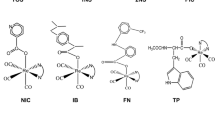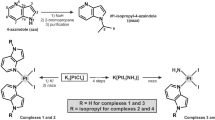Abstract
The platinum(II) complex PtCl2(meso-6), which has the estrogenic ligandmeso-1,2-bis(2,6-dichloro-4-hydroxyphenyl)ethylenediamine (meso-6), has been reported to be an effective antitumor drug for estrogen-receptor(ER)-positive tumors in animal experiments. The goal of this study was to investigate whether the observed biological effects could be ascribed to the intact PtCl2(meso-6). Cultures of the ER-positive human breast cancer cell line MCF-7 were used as the in vitro test system. In culture medium containing 10% fetal calf serum, PtCl2(meso-6) had a half-life of about 2 h, as determined by HPLC analysis, and no PtCl2(meso-6) was detectable after 10 h. The Pt complex bound irreversibly to serum protein. After 30 min, the diamine ligand was found released, with a maximum conversion of about 35% at 24 h. At this time the culture medium still had estrogenic activity, i. e. it induced ER processing in the MCF-7 cells. This indicates that the estrogenic effect was elicited by the released diamine ligand. In contrast, the growth-inhibitory activity of the medium preincubated with PtCl2(meso-6) was lost at a rate similar to the rate of loss of PtCl2(meso-6) from the medium. This accords with the platinum complex being the main cytotoxic entity. When MCF-7 cells were incubated with PtCl2([3H]meso-6), no free Pt complex could be identified in cellular extracts, and most of the cell-associated radioactivity coeluted with meso-6 in HPLC analysis. After 12 h, only 1.4% of the total cellular platinum was bound to DNA, but no tritium label could be detected. In conclusion, diamine ligand is released from the Pt(II) complex and can account for the estrogenic effects so far ascribed to PtCl2(meso-6).
Similar content being viewed by others
Abbreviations
- Cisplatin cis :
-
diamminedichloroplatinum(II)
- E 2 :
-
17β-estradiol
- ER :
-
estrogen receptor
- FCS :
-
fetal calf serum
- meso-6 meso :
-
1,2-bis(2,6-dichloro-4-hydroxyphenyl)ethlendiamine
- PtCl 2(meso-6):
-
[meso-1,2-bis(2,6-dichloro-4-hydroxyphenyl)ethylenediamine]dichloroplatinum(II)
References
Altman J, Castrillo T, Beck W, Bernhard G, Schönenberger H (1991) Metal complexes with biological important ligands. 62. Platinum(II) complexes of 3-(2-aminoethoxy)estrone and-estradiol. Inorg Chem 30: 4085–4088
Angerer E von, Birnböck H, Knebel N (1989) Platinum complexes with a selective action on estrogen receptor-positive mammary tumors. Anticancer Drug Des 4: 21–35
Bednarski PJ (1992) Relationship between the aqueous chemistry and the in vitro cytotoxic activities of mixed-amine cisplatin analogues. Biochem Pharmacol 43: 2609–2620
Bednarski PJ (1995) Reactions of a cisplatin-analogue bearing a 1,2-diarylethylenediamine ligand with sulfur-containing amino-acids and glutathione. J. Inorg Biochem (in press)
Bednarski PJ, Trümbach B, Kratochwil NA, Schönenberger H (1992) Diamine ligand release from the cisplatin analogue [meso-1,2-bis(2,6-dichloro-4-hydroxyphenyl)ethylene-diamine]dichloroplatinum(II) in cell culture medium. J Med Chem 35: 4479–4485
Bednarski PJ, Kratochwil NA, Otto AM (1994) Reversible and irreversible interactions of a cisplatin analog bearing a 1,2-diphenylethylenediamine ligand with plasma and plasma proteins in vitro. Drug Metabol Dispos 22: 419–427
Chesne C, Leclercq G, Pointeau P, Patin H (1986) Synthesis and biological studies of aminoestradiol-platinum(II) conjugates. Eur J Med Chem 21: 321–327
DiZio JP, Carlson KE, Bannochie CJ, Welch MJ, Angerer E von, Katzenellenbogen JA (1992) Estrogen platinum-diamine complexes: preparation of a non-steroidal estrogen platinum-diamine complex labeld with platinum-191 and a study of its binding to the estrogen receptor in vitro and its tissue distribution in vivo. J Steroid Biochem Mol Biol 42: 363–373
Fichtinger-Schepman AMJ, Oosterom AT van, Lohmann PHM, Berends F (1987)cis-Diamminedichloroplatinum(II)-induced DNA adducts in peripheral leukocytes from seven cancer patients: quantitative immunochemical detection of the adduct induction and removal after a single dose of cis-platinum. Cancer Res 47: 3000–3004
Foka M, Belehradek J. Jr, Paoletti J (1988) Interaction ofcis-diamminedichloroplatinum(II) with sensitive and resistent L1210 cell lines. Drug binding to nuclei and DNA. Biochem Pharmacol 37: 3467–3472
Georgiadis MP, Haroutounian SA, Chondros KP (1987) Synthesis and biological studies of steroidal cis-platinum(II) complexes. Inorg Chim Acta 138: 249–252
Hydes PC, Russel MJH (1988) Advances in platinum cancer chemotherapy. Advances in the design of cisplatin analogues. Cancer Metastasis Rev 7: 67–89
Janaky T, Jujasy A, Rekasi Z, Sertözö P, Pinski J, Bokser L, Srkalovic G, Milovanovic S, Redding TW, Halmos G, Nagy A, Schally AV (1992) Short-chain analogues of luteinizing hormone releasing hormone containing cytotoxic moieties. Proc Natl Acad Sci USA 89: 10203–10207
Karl J, Gust R, Spruß T, Schneider MR, Schönenberger H, Engel J, Wrobel KH, Lux F, Trebert-Haeberlin S (1988) Ring-substituted [1,2-bis(4-hydroxyphenyl)ethylenediamine]dichloroplatinum(II) complexes: compounds with a selective effect on the hormone-dependent mammary carcinoma. J Med Chem 31: 72–83
Koch M (1993) Optimierung analytischer Methoden (AAS, HPLC) zur Weiterentwicklung neuartiger Platin(II)-Komplexe. Doctoral thesis, University of Regensburg
Luby-Phelps K (1994) Physical properties of cytoplasm. Curr Opin Cell Biol 6: 3–9
Macquet J-P, Butour J-L (1983) Platinum-amine compounds: importance of the labile and inert ligands for their pharmacological activities toward L1210 leukemia cells. J Natl Cancer Inst 70: 899–905
Mauldin SK, Gibbons G, Wyrick SD, Chaney SG (1988a) Intracellular biotransformation of platinum compounds with the 1,2-diaminocyclohexane carrier ligand in the L1210 cell line. Cancer Res 48: 5136–5144
Mauldin SK, Plescia M, Richard FA, Wyrick SD, Voyksner RD, Chaney SG (1988b) Displacement of the bidendate malonate ligand from (d,l-trans-1,2-diaminocyclohexane)-malonatoplatinum(II) by physiologically important compounds in vitro. Biochem Pharmacol 37: 3321–3333
Müller R, Gust R, Bernhardt G, Keller C, Schönenberger H, Seeber S, Osieka R, Eastman A, Jennerwein M (1990) [Dl-1,2-bis(2-hydroxyphenyl)ethylenediamine] dichloroplatinum(II), a new compound for the therapy of ovarian cancer. J Cancer Res Clin Oncol 116: 237–244
Otto AM, Faderl F, Schönenberger H (1991) Dissociation of estrogenic and cytotoxic properties of an estrogen receptor binding platin complex in human breast cancer cell lines. Cancer Res 51: 3217–3223
Otto AM, Bednarski PJ, Eggers H, Trümbach B, Schönenberger H (1992) [meso-1,2-bis(2,6-dichloro-4-hydroxyphenyl)ethylenediamine]dichloroplatinum(II), an estrogenic Pt(II)-complex for the therapy of breast cancer: relationship between stability and effect. Pharm Pharmacol Lett 1: 103–106
Pinto AL, Lippard SJ (1985) Binding of the antitumor drugcis-diamminedichloro-platinum(II) (cisplatin) to DNA. Biochim Biophys Acta 780: 167–180
Roberts JJ, Fraval HNA (1978) The interaction of antitumor platinum compounds with cellular DNA in cultured cells and animal tissues: relationship to DNA cellular repair processes. Biochimie 60: 869–877
Robins AB (1982) The binding of platinum ethylenediamine dichloride to proteins, in vitro and in vivo. Chem Biol Interact 38: 349–356
Robins AB, Leach MO (1983) Pharmacokinetics of therapeutic doses of isotopically labeled platinum antitumor agents in the mouse and rat. Cancer Treat Rep 67: 245–252
Schmidt W, Chaney SG (1993) Role of carrier ligand in platinum resistance of human carcinoma cell lines. Cancer Res 53: 799–805
Schneider MR, Spruß T, Schiller C-D, Humm A, Schönenberger H (1988) Selective prostatic tumor inhibiting effect of an endocrine active platinum complex. Prog Cancer Res Ther 35: 509–513
Schönenberger H, Wappes B, Jennerwein M, Berger M (1984) Developement of selectively acting platinum complexes. Cancer Treat Rev 11 [Suppl A]: 125–130
Wheeler P, Berube G (1993) The synthesis of new platinum(II) complexes linked to non-steroidal estrogens. Inorg Chim Acta 209: 97–99
Author information
Authors and Affiliations
Rights and permissions
About this article
Cite this article
Otto, A.M., Kratochwil, N.A., Eggers, H. et al. Chemical stability, biological activity and cellular uptake of a cisplatin analogue having a 1,2-diarylethyleneamine ligand in cultures of human breast cancer cells. J Cancer Res Clin Oncol 121, 31–38 (1995). https://doi.org/10.1007/BF01202726
Received:
Accepted:
Issue Date:
DOI: https://doi.org/10.1007/BF01202726




